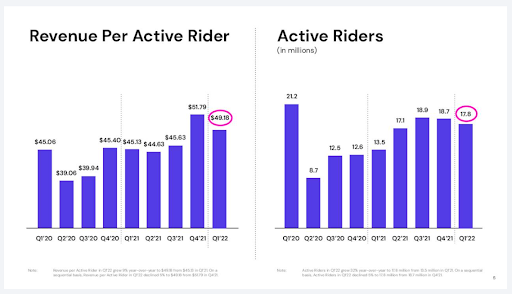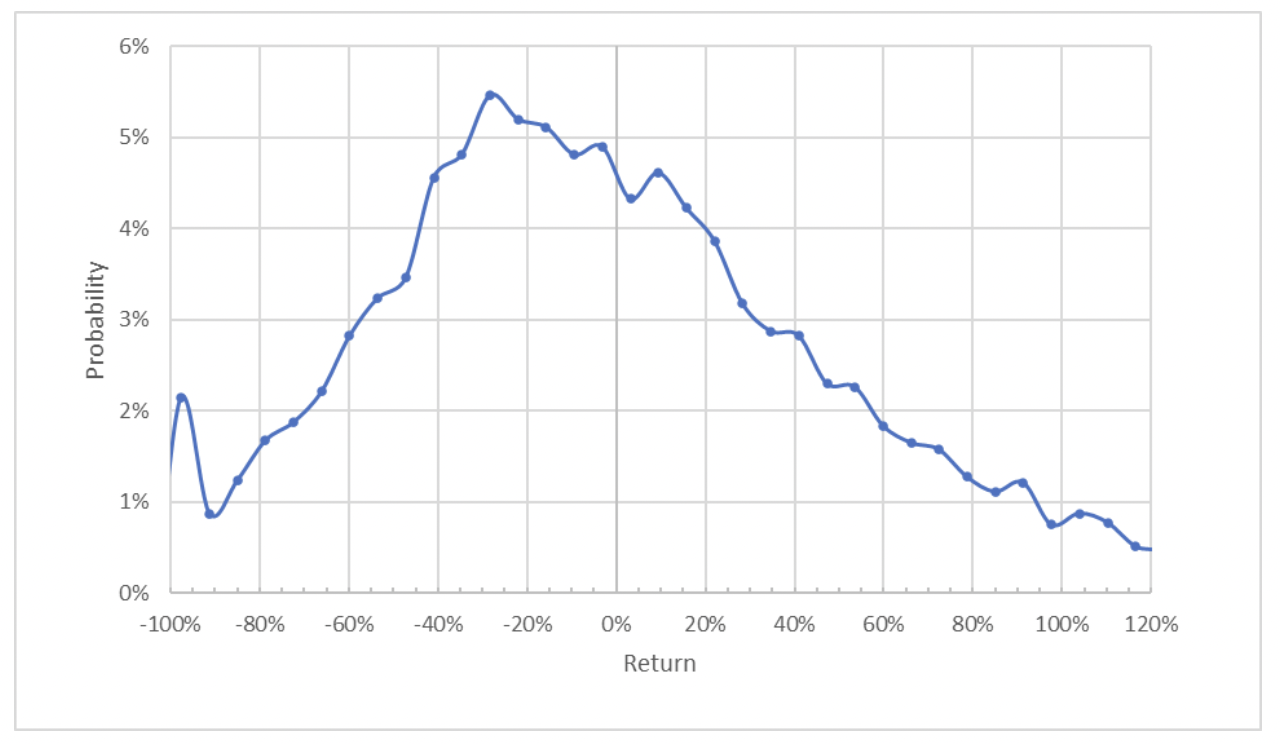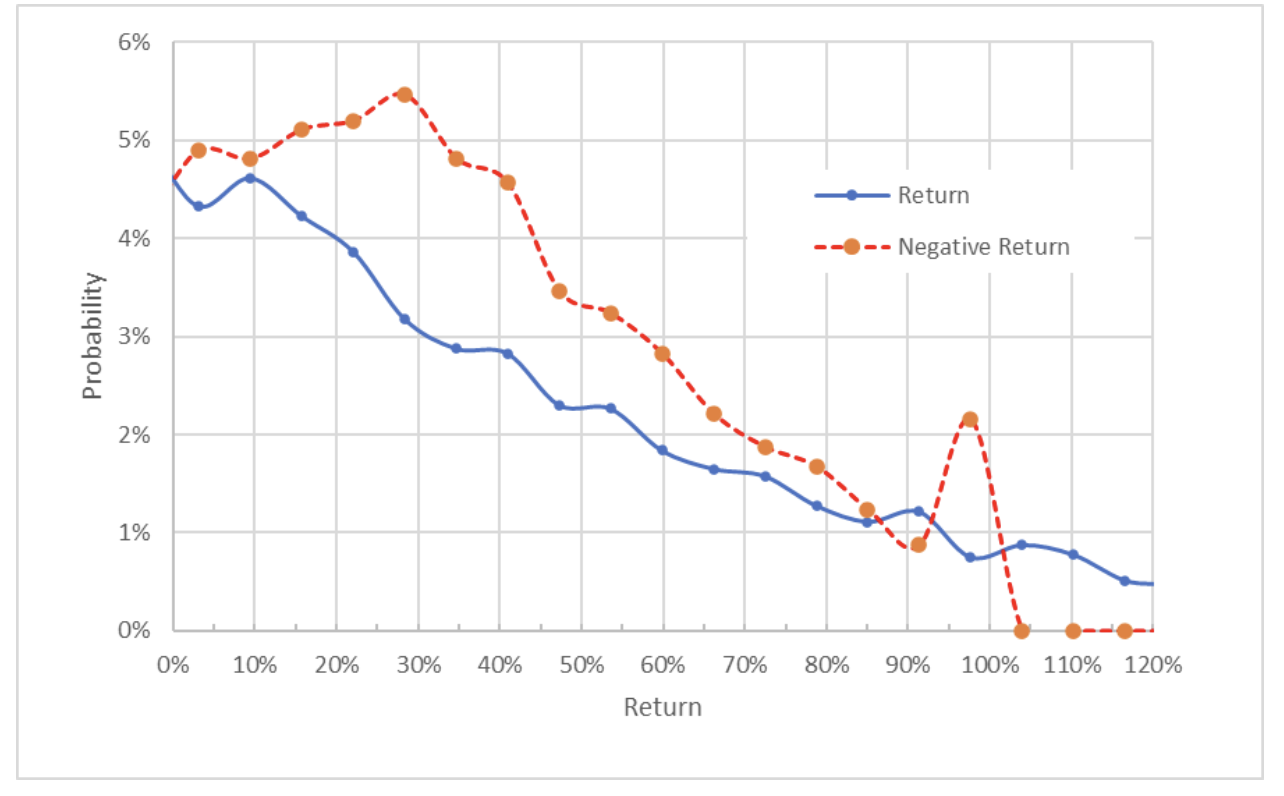- LYFT Q1 results May 3 slightly beat expectations on EPS
- Shares fell 30% in day following Q1 results and are 67% below 12-month high close of July 2, 2021
- Investors becoming skeptical about prospects for ride hailing platforms
- Analyst rating is bullish, with a consensus price target more than twice current share price
- If you’re interested in upgrading your search for new investing ideas, check out InvestingPro+
What a difference a year makes. One year ago, LYFT (NASDAQ:LYFT) was trading at $50.07, on its way to a 12-month high close of $62.79 hit on July 2, 2021. The company reported Q1 results May 3, beating expectations, but the shares have declined sharply since. The shares are currently training at $20.51, 67% below the 12-month high close and down 52% so far this year.

(Source: Investing.com)
Against this backdrop of the collapsing valuation, it should be noted that LYFT has been on a steady and consistent path to profitability, with three consecutive quarters of positive (albeit small) earnings. Given the challenging business conditions of recent years, management deserves substantial credit.

(Source: E-Trade)
The current environment of high gas prices, rising wages in service jobs, along with driver dissatisfaction (not unrelated to the cost of fuel and higher hourly pay in other lines of work) has been a significant headwind for LYFT (as well as Uber (NYSE:UBER)). Management is trying to bring in new drivers and re-engage with those who have cut back their hours or quit.
The market is currently intolerant of any setbacks in growth, and the Q1 results highlighted two worrisome numbers. First, revenue per active rider is lower for Q1 of 2022 compared with Q4 of 2021. Second, the number of active riders has now fallen for two consecutive quarters.

(Source: Lyft Inc)
Another challenge for LYFT, along with other high growth/low earnings companies, is that rising interest rates have a disproportionately negative impact on valuations. The discount rate that is applied to estimated future earnings in calculating the fair value of a stock rises with interest rates. The more of the value of a stock that comes from earnings far into the future, the more the valuation drops with rising interest rates.
I have not written about LYFT before, but I wrote about Uber in July and October of 2021. The business models pursued by Uber and LYFT depend on a large population of poorly-paid on-demand workers. Even if these companies can figure out the marginal increase in pay required to get people to work as on-demand drivers, the consistency of these services and the stability of their rates are uncertain. In addition, there are significant outstanding issues relating to worker rights, the ability to organize, etc.
In evaluating a stock, I rely on two forms of consensus outlooks. The first is the well-known Wall Street analyst consensus rating and price target. The second is the market-implied outlook, which represents the consensus view among buyers and sellers of options on a stock. For readers who are unfamiliar with the market-implied outlook, a brief explanation is needed. The price of an option on a stock reflects the market’s consensus estimate of the probability that the stock price will rise above (call option) or fall below (put option) a specific level (the option strike price) between now and when the option expires. By analyzing the prices of call and put options at a range of strike prices, all with the same expiration date, it is possible to calculate a probable price forecast that reconciles the options prices. This is the market-implied outlook.
I have calculated the market-implied outlook for LYFT to early 2023 and compared this with the current Wall Street consensus outlook in evaluating the stock.
Wall Street Consensus Outlook For LYFT
E-Trade calculates the Wall Street consensus outlook for LYFT using ratings and price targets from 27 ranked analysts who have published opinions in the past three months. The consensus rating is a buy, as it has been for the past 12 months, while the consensus price target is $45.20, 120% of the current share price. The dispersion among the individual price targets is extremely high, with the highest being more than three times the lowest. When there is a wide spread in the price targets for a stock, there tends to be a negative correlation between the consensus price target and the subsequent returns. As such, the Wall Street consensus outlook for LYFT tends to suggest a somewhat bearish view.

(Source: E-Trade)
Investing.com calculates the Wall Street consensus outlook for LYFT by combining ratings and price targets from 43 analysts. The results are very similar to those from E-Trade, with a bullish rating, a price target that is 124% above the current price and a high level of dispersion among the individual analyst price targets.

(Source: Investing.com)
As a rule of thumb, I discount or entirely ignore the consensus price target when there is a spread of more than 2X between the highest and lowest price targets. In addition, the consensus rating has been bullish through all of the past year’s declines, which does not inspire confidence. I interpret the consensus outlook for LYFT to be somewhat bearish.
Market-Implied Outlook For LYFT
I have calculated the market-implied outlook for LYFT for the 8.4-month period between now and Jan. 20, 2023, using the prices of call and put options that expire on this date. I selected this expiration date to provide a view through the end of 2022 and because options expiring in January tend to be among the most actively traded.
The standard presentation of the market-implied outlook is a probability distribution of price returns, with probability on the vertical axis and return on the horizontal.

(Source: Author’s calculations using options quotes from E-Trade)
The market-implied outlook shows a high level of positive skewness, with the highest-probability outcomes corresponding to negative returns to early 2023. The maximum probability outcome corresponds to a price return of -28%. This is a bearish outlook. The annualized volatility calculated from this outlook is 68%. It is also notable that there is a small peak in probability at a return of -100%, which would correspond to a complete loss. It is not uncommon to see this result for stocks with very high volatilities.
There is a body of research that shows that stocks with high expected skewness tend to generate lower subsequent returns (and vice versa). This effect is also seen for stocks with high historical skewness. This result is consistent with investors having a behavioral bias that favors stocks with ‘lottery ticket’ return potential, meaning very high returns with a very low probability.
To make it easier to directly compare the probabilities of positive and negative returns, I rotate the negative return side of the distribution about the vertical axis (see chart below).

(Source: Author’s calculations using options quotes from E-Trade)
This view highlights the bearishness of the market-implied outlook. The probabilities of negative returns are much higher than the probabilities of positive returns of the same magnitude, across a wide range of the most probable outcomes. (The dashed red line is significantly above the solid blue line over most of the left two-thirds of the chart above).
Theory suggests that the market-implied outlook will tend to have a negative bias because investors, in aggregate, are risk averse and tend to overpay for downside protection (e.g. put options). The degree of bearishness observed here for LYFT is quite extreme relative to the range of equities that I have analyzed using this approach, so I am confident in the bearish interpretation.
Summary
The business model for ride hailing using gig-work drivers has come of age, and the challenges of this concept are increasingly clear. The current economic conditions may be something of a perfect storm for this concept. Rising hourly wages for service jobs, along with high fuel prices, make it harder for LYFT to attract and retain drivers. In addition, investors are less patient because rising interest rates are hammering LYFT’s net present value.
Finally, there are a host of regulatory and labor issues that are in play, and these have the potential to reduce the profitability of the ride-sharing platforms. While LYFT has made steady progress to reach profitability, this may not be enough for investors. The Wall Street consensus rating is bullish, with a consensus 12-month price target that is more than twice the current share price, but the level of disagreement between the analysts is a bearish indicator. The market-implied outlook for early 2023 is also bearish, with high volatility. I am assigning a bearish/sell rating on LYFT.
Interested in finding your next great idea? InvestingPro+ gives you the chance to screen through 135K+ stocks to find the fastest growing or most undervalued stocks in the world, with professional data, tools, and insights. Learn More »
Which stock should you buy in your very next trade?
AI computing powers are changing the stock market. Investing.com's ProPicks AI includes 6 winning stock portfolios chosen by our advanced AI. In 2024 alone, ProPicks AI identified 2 stocks that surged over 150%, 4 additional stocks that leaped over 30%, and 3 more that climbed over 25%. Which stock will be the next to soar?
Unlock ProPicks AI